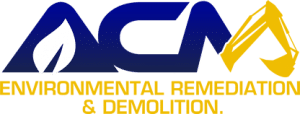Asbestos inspections and abatement are procedures that should always be handled with the utmost care, following all safety guidelines to ensure the health and safety of everyone involved. It is also crucial to consider the impact of asbestos on the environment, ensuring every precaution is taken to mitigate any potential contamination.
Safety is the number one concern when testing and handling asbestos-containing materials. Keep reading to learn more about the safety procedures and guidelines for an asbestos inspection.
Who Should Perform an Asbestos Inspection?
Part of the safety of asbestos inspections lies in who performs the inspection. DIY asbestos inspection kits on the market will allow you to extract samples of materials on your property and send them for analysis. However, these kits do not provide all the necessary resources to perform the inspection without putting yourself or others at risk of asbestos exposure.
An asbestos survey should always be performed by a certified asbestos professional with the experience to properly and safely inspect the property, including sample taking. Not only will an expert know how to mitigate any potential risk, but they will have the technology and equipment to protect you, your property, and the environment in the process.
An asbestos inspection firm will also have the proper licensing and professional liability insurance coverage for environmental testing. Professional liability insurance coverage protects you, as the owner, because without it, you will have no legal right to demand compensation for damages due to errors in professional judgment, which are beyond the reach of a contractor’s general liability insurance.
Asbestos Inspection Safety Procedure
Part of the safety procedures for an asbestos inspection is having the proper equipment to mitigate the risk of asbestos exposure. When performing an inspection, an expert utilizes specialty equipment to take samples while preventing asbestos fibers from releasing into the atmosphere, workers’ personal protective equipment to ensure their safety, and specialty equipment to contain and transport samples and clean up.
Before any samples can be taken in any given space, the area must be isolated from the rest of the property. Part of that procedure involves cutting the area off from all ventilation, including shutting down HVAC units and sealing vents, then sealing the area with plastic sheeting. These practices help ensure that no asbestos fibers travel beyond the space, putting the environment and others on the property at risk. eo.
Anyone involved in an asbestos inspection where sample taking is needed, and there is potential to disturb asbestos-containing materials must wear worker personal protective equipment (PPE). PPE is specially designed to minimize the risk of asbestos exposure. PPE involves disposable protective clothing like coveralls, head covers, and foot covers, all made of synthetic fabric that does not permit asbestos fibers to pass through.
In addition to the protective clothing, an asbestos inspection expert must wear proper respiratory protection. A disposable paper dust mask is not sufficient for dealing with asbestos. A negative-pressure, air-purifying half or full-face respirator with replaceable filters or a powered air-purifying half or full-face respirator can be used.
During sample taking and clean up, air monitoring is conducted throughout the process to ensure a safe environment. Samples are extracted and placed in a leak-tight, sealed container using portable power tools equipped with special local ventilation attachments. These samples are then sent to a lab for testing.
The cleaning practice typically utilized to ensure any asbestos fibers are collected and removed is wet cleaning with the use of HEPA filter vacuums. Wet cleaning or wet wiping picks up any asbestos fibers without re-suspending them in the air. Any cloths, rags, or mops used in wet cleaning will be properly discarded as asbestos waste while still wet. HEPA filter vacuums may be used with wet cleaning or in place of wet cleaning. The filters of the vacuum are equipped to handle very small particles, like asbestos fibers. HEPA vacuums are emptied in an isolated area with protective gear and placed into properly labeled, leak-tight, sealed containers for asbestos waste disposal.
The asbestos expert will follow all decontamination protocols, including containing or disposing of spoiled clothing and washing off before changing back into street clothes. Depending on the scale of the inspection or in the case of abatement, there may be isolated decontamination areas on the property for workers to remove protective gear and ensure no asbestos fibers are released into the air.
Why Choose the ACM Team for Asbestos Inspection Services
When you choose ACM, you can be assured our inspections are done with the most modern technology to guarantee precision and accuracy. We use crafted expertise and skills to conduct a comprehensive survey of your property for asbestos-containing material before we start with asbestos removal or management processes.
With the ACM Team, you can trust that our asbestos inspection experts are experienced professionals who will provide a personalized plan and safe process for removing hazardous materials from your property. With over 20 years of expertise in this industry, we guarantee satisfaction with every project. Contact us today at (603) 319-1270 to learn more about our services and how we can help you.














